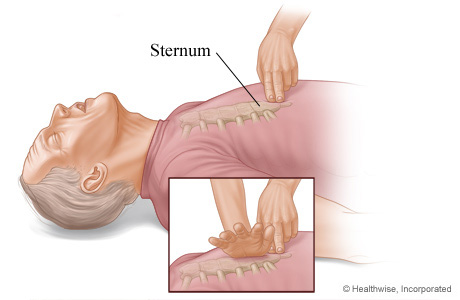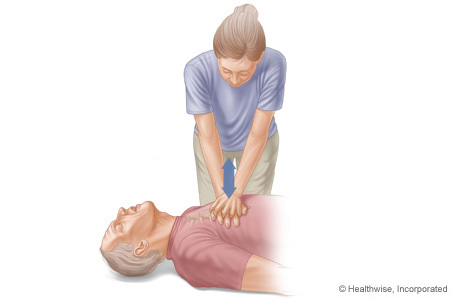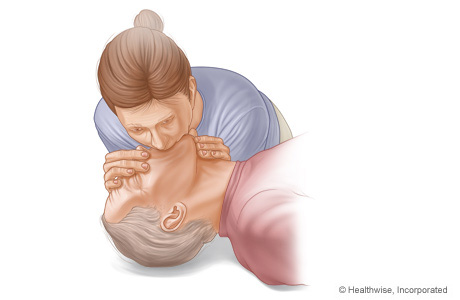First aid treatment for a possible spinal injury: Overview
The possibility of a spinal injury must be considered anytime an accident involves the head, face, neck, or back. Permanent paralysis may be avoided if the injured person is kept from moving (immobilized) and is transported correctly.
Do not move the person.
If you think the person may have a spinal injury, do not move them unless there is an immediate threat to their life, such as a fire. If there is immediate danger, keep the person's head and neck supported and in a straight line while you move them to a safe place.
Do not remove the person from the water if they were in a diving accident. Float the person face up in the water until help arrives.
Call emergency services.
Call 911 or other emergency services to transport the injured person if you think they may have a spinal injury. This will reduce the risk of more injury to the spinal cord.
How to deal with an emergency
Review this topic before you need it. Then when you are faced with an emergency or injury, you will know what to do. Your confidence in dealing with both major and minor emergencies will reassure an injured person.
Here are the steps to take when an emergency occurs.
- Take a deep breath.
- Count to 10.
Tell yourself that you can handle the situation.
- Check for danger.
Protect yourself and the injured person from fire, explosions, or other hazards.
- Try to look at the situation as a whole.What is the most serious problem, and what do you need to do first? The most obvious problem isn't always the most serious.Treat the most life-threatening problems—like bleeding or shock—first.If you think that the person has a spinal injury, don't move the person unless the danger is great.Check for broken bones and other injuries.
If the person is unconscious or doesn't respond to your voice or touch, be ready to start CPR.
Call 911 or other emergency services, such as the local fire department, sheriff, or hospital, if you need help.
How to give CPR (cardiopulmonary resuscitation) to an adult
CPR includes the steps C-A-B:
- C is for giving chest compressions.
- A is for opening the airway.
- B is for using rescue breathing.
Take a class on how to give CPR. Then you can use the steps below as a reference.
CPR can also be done with only compressions. This is sometimes called hands-only CPR.
- Check to see if the person is conscious.
Tap the person's shoulder and shout, "Are you okay?" If the person doesn't respond, follow these steps:
Call 911 or other emergency services or ask someone else to call. Then start CPR.If you are alone and don't have a phone, start CPR. Do CPR for 2 minutes. Then call 911.Get an AED (automated external defibrillator) if there is one nearby. - Start chest compressions.
 Kneel next to the person.Use your fingers to locate the end of the breastbone (sternum), where the ribs come together.Place two fingers at the tip of the breastbone.Place the heel of the other hand just above your fingers (on the side closest to the person's face).Stack your other hand on top of the one that you just put in position. Lace the fingers together, and raise your fingers so they don't touch the chest.Straighten your arms, lock your elbows, and center your shoulders directly over your hands.Use both hands to give compressions.
Kneel next to the person.Use your fingers to locate the end of the breastbone (sternum), where the ribs come together.Place two fingers at the tip of the breastbone.Place the heel of the other hand just above your fingers (on the side closest to the person's face).Stack your other hand on top of the one that you just put in position. Lace the fingers together, and raise your fingers so they don't touch the chest.Straighten your arms, lock your elbows, and center your shoulders directly over your hands.Use both hands to give compressions. Press down in a steady rhythm, using your body weight.
Press down in a steady rhythm, using your body weight.The force from each thrust should go straight down onto the breastbone, pressing it down at least 2 inches. Be sure to let the chest re-expand at the end of each compression.
Give 100 to 120 chest compressions a minute.Push hard and push "fast." (Fast means to push about 2 times a second.)
If it helps, push to the beat of a song (like "Staying Alive") that has 100 to 120 beats per minute.
If you are trained in CPR, start rescue breaths. (See Step 3.)If you aren't trained in CPR, keep giving 100 to 120 chest compressions a minute until help arrives, an AED is ready to use, or the person is breathing normally. - Start rescue breaths.

Note that if you aren't trained in CPR, it's okay to only give chest compressions.
If you are trained in CPR:
- Give 30 compressions, then 2 rescue breaths.
- Repeat the cycle of 30 compressions and 2 rescue breaths until help arrives, an AED is ready to use, or the person is breathing normally.
To give rescue breaths:
Put one hand on the person's forehead. Gently tilt the person's head back. Do not tilt the head or chin if you think there is a neck injury.Pinch the person's nostrils shut with your thumb and finger.Put the fingers of your other hand under the bony part of the lower jaw near the chin. Tilt the chin upward to keep the airway open.Take a normal breath (not a deep one), and place your mouth over the person's mouth, making a tight seal.Blow into the person's mouth for 1 second, and watch to see if the person's chest rises while keeping the chin tilted.If the chest doesn't rise, tilt the person's head again and give another breath.
Between rescue breaths, remove your mouth from the person's mouth and take a normal breath.Let the person's chest fall, and feel the air escape.
©2011-2026 Healthwise, Incorporated
